The Caribbean single-seater races of 1959-'62
Racing Juniors in the tropics
Author
- Lorenzo Baer
Date
- November 8, 2023; updated with Venezuela addition on December 7, 2023
Related articles
- 1968 Argentinian F2 Temporada - The quick dash of the Cavallino Rampante in the Argentinian Pampas, by Lorenzo Baer
- 1971 Colombian F2 Temporada - When Formula cars roared in the Coffee Land, by Lorenzo Baer
Who?Suzy Dietrich What?Elva-DKW 300 Where?Antilles Circuit, Cáguas When?Trofeo Corazón, I Puerto Rico GP (November 9, 1962) |
 |
Why?
Ah, the Caribbean... nowadays we remember it as a place of beautiful white sand beaches, sun, peace and tranquility. But 60 years ago, the Caribbean was also the land of motors. Cars zipped along at over 200 kilometers per hour on some of the most breathtakingly scenic sights on the planet: the beaches and historic center of Havana, the rainforest of Puerto Rico or the coral islands of the Bahamas.
The region has always had that special appeal, especially in the colourful 50s and 60s, when motorsport was very different from what it is today. Mix a few powerful cars, with some good and fearless drivers, plus some minimally helpful organisers and voilà: we have a GP! Motorsport has evolved a lot since then, without a doubt.
Most of the peculiar GPs and races in the region in the 60s had grand-touring cars as their main stars: Ferraris, Jaguars and Lotuses, driven by the great stars of European and North American motorsport who at least once a year came in to visit the region not only for pleasure, but for business.
In addition, even if the GTs stole the public's attention, many of these events had another dozen supporting categories, which always helped to populate the weekends of these major contests: sports car races, single-brand races, adapted civilian cars races, even karts! Quantity, combined with the quality that some races could provide, was the essential set for the success of these events.
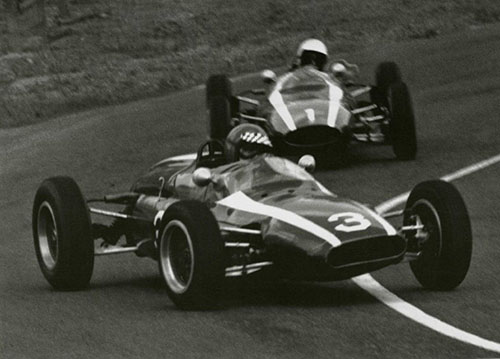
Tim Mayer (#1) chases Peter Revson (#3) in the 1962 Puerto Rico GP. (credits Tom Burnside Collection)
But one of the most special categories that always participated in these contests was Formula Junior. These small and friendly cars were always ostracized at these events, even though they were considered the 'second' most important category to perform, obviously only behind the big GTs.
But why was FJ so underrated? Because of the combination of two points: the first was that many of these Formula Junior races did not have names as big as those of the GT and touring races; and, at the same time, they also failed to attract many local drivers, unlike the lower categories (which were much more affordable), which scared away the interest of the local public.
Even so, the Formula Junior marked its history in the Central American and Caribbean motorsport, because, for many years, it was the only international single-seater category to race in the region. The FJs were undoubtedly responsible for one of the first expansions of the single-seater cars on the global stage, allowing it to race in places that were previously considered impossible to host a Formula race.
Formula Junior: a short story
The initial idea for the category was conceived in 1957 by Count Giovanni “Johnny” Lurani, as an initiative to try to re-insert Italian drivers in an international motorsport scene. The problem Lurani faced was that the old generation of drivers from the tarantella land, made up of Farina, Ascari, Viloresi, Taruffi, Castelotti and Musso, had already entered their twilight, and there was no one to replace them.
Their places were now taken by countless Brits, Aussies, New-Zealanders, Americans and Belgian drivers, who made up the roster of most of the F1 teams. In addition, the count noted the great gap that existed between a driver in the lower (F2 and F3) and higher (F1) categories of motor racing, in terms of competition, as well as commercial and economic perspectives.
This is the scenario that makes it possible for the FJ to arise in 1958: first as a regional category, containing almost solely Italian drivers and circuits, then quickly spreading across Europe. In less than two years, there were a dozen national Formula Junior championships spread around the world, in addition to another large number of races open to cars in the category, but which could not be considered official FJ races (in other words, Formula Libre races).
The engineering behind the idea was quite simple by the way: the requirement was that the cars needed to have as many existing production components as they could, in order to keep operating costs as low as possible. Engines were to have no overhead camshafts and capacity could be changed only by altering the bore. The number of crankshaft bearings had to be the same as on the original engine, and all types of limited-slip differentials were banned, the same also applying to changes in the location of the camshafts.
Like the engines, the gearboxes had to come from a touring car that had already gone through FIA scrutiny. Besides that, the brake and carburetion systems had to be factory standard, and both needed to have the same origin as the engine (although many teams circumvented the rules in this regard, installing light alloy brake drums and prepared Weber carburetors).
Other details were also discussed and quickly agreed upon by all interested builders: the minimum wheelbase was 78¼ inches, the minimum track was 43 inches, and the minimum width 37½ inches. And it was generally agreed that the cars should only run on commercial fuel, without relying on special mixtures developed for motorsport.
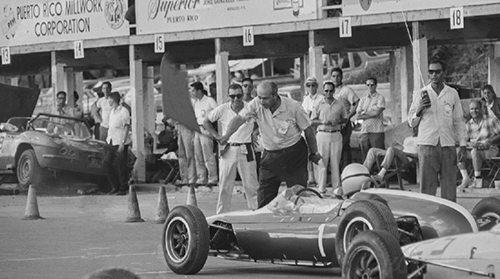
The races in Puerto Rico were so weird that guess who flagged-off the start - none other than Juan Manuel Fangio himself. (credits Albert R. Bochroch Photograph Collection & the Revs Institute)
Even so, there was a certain degree of freedom from the rules in relation to other parts of the car: the weight limit was quite relative, as long as a formula of car weight x engine capacity was followed. For example, in European championships, 1100cc engines had to be fitted to cars weighing a minimum of 396kg, while 1000cc cars had a minimum weight of 357kg. This left more room for builders, allowing for greater creativity in machine designs.
Other parts of the original regulations were more 'suggestions' than obligations: steel bars inside the car's spar, mainly near the cockpit, to protect the drivers in case of an accident were almost never installed. Just like seat belts, which were considered optional accessories rather than mandatory items.
It was a common joke at the time that the original FJ regulation could fill only a single sheet. And as incredible as it sounds, it's true! Throughout its short existence, from 1958 to 1963, the category always valued the principles of creativity, competitiveness and low cost, which allowed the regulations to be much more permissive than most of the other single-seaters categories. These values were what made the Formula Junior go beyond barriers, transforming the impossible dream of certain countries of hosting a Formula race into something tangible.
But why then this ephemerality of Formula Junior, which ended as quickly as it expanded, in less than five years? Because of a simple combination of events, which were caused mostly by that very meteoric rise. Another point is that even though it was conceived as just another category, FJ supplanted F3 in 1960. The point is that even unconsciously, FJ had entered the same market niche as F3 (since the British and other smaller European F3 championships used 500cc engines), offering, as already mentioned, a better product, with lower cost and higher return. And, quickly, Formula 2 also began to be swallowed by FJ, because of the same reasons.
The real issue started when what was supposed to be just another evolutionary stop in a driver's career, ended up becoming the step before F1! Consequently, costs rose exorbitantly, starting to make it impossible for amateur and semi-pro drivers to participate in the races – and since they were 90% of the grids, FJ became a hoax in itself: to have a development category without there being human material to be developed.
So, in the beginning of 1964 and 1965, both F2 and F3 were restructured, incorporating some of the lessons of the original FJ regulations. And, even with the end of the category in a short period, it was not at all a waste of time and dedication. After all, Count Lurani's initial objective was partly achieved: Lorenzo Bandini, Ludovico Scarfiotti and Giancarlo Baghetti were some of the fruits of the Formula Junior generation of the 50s and 60s, and they would be part of one of the last great generations of Italian motorsport.
Formula Junior cars
Since Formula Junior had its origins in Italy, it is not surprising that small Italian constructors reigned dominant in the early years of the category's existence. In addition, there was an abundant offer of parts and qualified labour for the construction of machines in the country, due to the restructuring of the Italian automobile industry in the post-war years.
Most of the cars used engines that were easily found anywhere in the country, mainly the four-cylinder Lancias and Fiats, with 1098cc. The biggest difference between the cars was due to the bodywork and chassis, which often sought to be based on designs already proven in higher categories.
The Stanguellinis, almost all of the 1100 model, were the most popular cars in the Italian FJ era. It was a compact vehicle, but with graceful lines, resembling most F1 cars of the time. And that's no wonder, as Stanguellini was a result of a joint work made by engineers Alberto Massimino and Ginacchino Colombo – both had participated in the development of the popular Maserati 250F F1 race car, in the mid-1950s.
However, underneath the beautiful aluminum bodywork, all resemblance to the most elaborate F1/F2 cars disappeared. The car had a simple ladder chassis structure, in which the Fiat engine was positioned angled to the right of the car's centerline, while the driver sat slightly to the left of it.

Venezuelan driver Edy Munõz in one of the many Stanguellini-Fiats of the early Formula Junior era.
(credits Motor de Venezuela)
But it wasn't just the Modena car manufacturer that made a name for itself at this time. Taraschi was the first to offer a real challenge to the overwhelming number of Stanguellinis on the grid. The company offered a car almost identical to the 1100 model, with the only real visible difference being that the Taraschi had a more traditional driver-engine arrangement, with both following the centerline of the car. In 1960, the Dagrada-Lancia appeared, a car that still carried the identity of the front-engined models (as it resembled a smaller copy of a hybrid between a Lotus 16 and a Vanwall VW5).
On the other hand, some Italian companies were beginning to pay attention to the revolution that was taking place in single-seaters at the end of the 50s. Wainer and De Sanctis, already in 1959, began to offer rear-engined cars, which were the state-of-art technology at the time. In addition, these cars had spaceframe chassis, which were far more advanced than the composite structures of the Stanguellinis, Dagradas and Taraschis. Even so, both the Wainer and the De Sanctis did not find great commercial success, being overshadowed by the cost and practicality of front-engined cars.
But everything changed when FJ sparked the interest of some builders outside Italy. As early as 1959, cars from DKW, MG TC, Goliath, Hansa, Wartburg, Triumph Herald, Hillman, Crosley, Peugeot, Simca, Saab, Renault and Panhard began to flood the market, as Formula Junior races began to multiply throughout Europe. Going even deeper in the data about it, it is estimated that between the end of 1959 and the beginning of 1960, there were over 70 different companies building FJ cars.
Almost all of these followed the traditional pattern proposed by the Italians, with an engine at the front of the car, a simple structure and a low-displacement engine. Others were already based on the F1 Coopers, with a rear engine, while there were more radical ones, which had engines mounted side-by-side with the drivers.
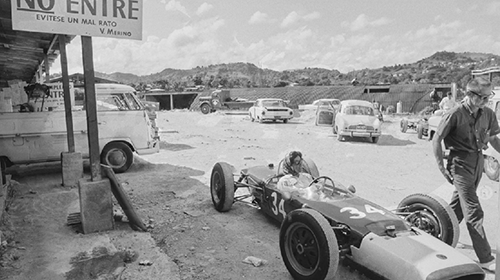
Suzy Dietrich campaigned her husband Chuck's Elva 300. (credits Albert R. Bochroch & the Revs Institute)
At that time, the German DKW cars were the ones that stood out the most, mainly due to their low cost and the infinite number of tuning options for the engine – some of which openly violated the rules of the category (and strange as it sounds, nobody cared about it!). However, it was soon found out that the DKWs were susceptible to serious problems (especially the engines) after a short cycle of more intense use, which greatly damaged the company's image as a builder of FJs in the following years.
In 1960, however, what would be the definitive transformation of the category began to emerge: by the end of the year, the BMC “A” and the Ford-Cosworth 105E series of engines had begun a total domination in Formula Junior. Front-engined cars began to be overshadowed by rear-engined cars, and by early 1961 any front-engined car had become extremely uncompetitive in any race of reasonable prestige.
For example, 1-litre Ford-Cosworth engines provided 72hp in the early 1960s, reaching 88hp by the end of the year. In contrast, the Fiat 1100c engine had practically reached the end of its development life, although it was claimed that under the right conditions, the machine could reach 80hp (which is extremely doubtful that was true, since the maximum ever verified for this engine were 78hp).
The Ford 105Es and BMCs equipped the ultimate generation of Formula Junior machines; Lotuses, Coopers, Elvas and Lolas had become the dominant cars before the end of the series in 1963, leaving little chance of an answer for the few remaining front-engined cars.
But as already mentioned, this had a cost: if in the beginning of Formula Junior, the machines were nothing more than a potpourri of semi-amateurish constructed vehicles, at the end of 1963, it was quite difficult to differentiate an FJ car from an F1 one (in the sense of equipment and in the structure itself, and how to assemble and maintain it).
In this case, it is worth looking at an example from the time: in the early 1960s, an Elva 100 could be bought for £840, a Lola Mk2 for £1,000, a Cooper T52 for £1,185, and a Lotus 18 for £1,250. At the end of the year, if you managed to buy any one of these cars for less than £1,500, you could consider yourself lucky – or someone who had just been scammed.
FJ: worldwide expansion
A big factor that led to the rapid multiplication of companies interested in building Formula Junior cars was their quick acceptance by the local motorsport federations. What was previously expected to be just another category of single-seaters, with the purpose of being one of the first steps in the driver's evolutionary ladder, became the basis of regional motorsport.
It was expected that Formula Junior, in its incipient beginnings, would be a category restricted to Italy. If it passed the micro test, it might expand to the macro context, which would be Europe. But the rapid success of the category already in its first stages made this whole process run over, and already in 1958, the FJ began to extrapolate the barriers of the Alps.
For example, when the GP of Portugal took place in August 1958, Formula Junior was invited to be one of the support events. And even though most of the drivers were Italian (as were the cars), the event was the first major evolutionary leap for FJ's expansion. The second came soon after, in October of the same year, when the small cars were also invited to participate in the Coupe du Salon, one of the most prestigious trophies at the time for racing cars.
The following two years were the ones that laid the foundations for the great expansion of Formula Junior around the world: in 1959, there were already official Formula Junior races in Italy, Germany, Austria, France, Denmark, Great Britain, going as far as the United States and the Soviet Union. 1960 was even more spectacular for the category, as it was from this point on that the FJ officially began to replace F3 as the ‘grassroots’ category of single-seater racing.
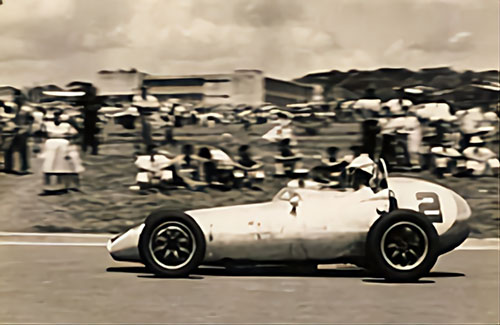
Some FJ cars raced in some truly peculiar places. Here, Duncan Forlong competes in a road race
in Santa Ana, El Salvador. May 1960.
1959 was also special for another reason: it was the first time that de-facto organized races for Formula cars were organized in the Caribbean. The region, which for a long time hosted seasonal international motorsport races, such as the Gran Premio de Cuba and the Nassau Speedweeks, has always been one of the most unique and fantastic places to host them.
Drivers of the calibre of Fangio, Moss, Portago, Shelby and Von Trips always attended these events, setting a tone of importance that few races in the world could boast. But what was always up in the air was the question that all these races were for touring and GT categories. Even though it was prestigious in itself to attract such drivers at these events, hosting an official race for single-seaters was the dream of any national sports federation at the time.
But the costs of organizing an F1 or F2 race at the time were exorbitant and prohibitively expensive, which forced the choice of the GT alternative. But when FJ began to stand out on the European scene, with its low-cost/competitiveness proposal, it finally opened the door to bring single-seater racing to Central America and the Caribbean.
Venezuela was the first stop on this journey; which, between 1959 and 1962, would cover some other countries in the Caribbean zone, in races that defied all possible difficulties in one of the most paradisiacal regions of the planet. And so begins the Formula Junior epic in Caribbean paradise.
1959
II Premio La Trinidad
- Official name of the Formula Junior race: Trofeo Rafael Staccioli
- Date: March 15
- Circuit: La Trinidad/Baruta Street Circuit
- Lap length: 4100m
- Overall winner: Azzuro Manzini (YV)
- Winning car: Stanguellini 1100
- Engine: Fiat 103 L4
The first Formula Junior race officially recorded in the Caribbean took place in 1959, on the outskirts of Caracas. Like so many other countries in the region, Venezuela had already hosted large-scale touring car races during the 1950s – and was now looking for any small opportunity to bring open-wheel cars to the country's circuits.
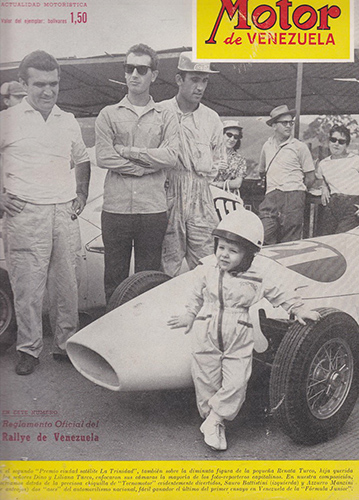
The cover of Motor de Venezuela with an image of the race.
This opportunity arose between 1958/'59, when Venezuelan investors began to hear the first rumors of FJ's success in Europe. Among them were Dr. Giacomo di Mase, manager and official distributor of FIAT cars in Venezuela, and Raffaele Staccioli, an Italian engineer and urban planner who ended up getting involved with the development of the FJ in the early 1960s. Staccioli was also one of the figures involved in promoting the Coppa Acerbo during the Italian fascist period, as the engineer was born in Pescara.
After talks between investors and Touring y Automóvil Club Venezuela (which even consulted J.M. Fangio to make its final decision), it was decided that the country would host a Formula Junior race – and it wasn't long before the first imported vehicles of the category began to disembark in Bolivarian ports.

Sergio Vivaldi (#14), Stanguellini-Fiat. (credits Motor de Venezuela)
From what has been recorded, six Stanguellinis arrived in this first batch of orders placed by Venezuelan drivers and investors. As soon as the cars set foot on Venezuelan soil, they were quickly presented to the public, as a great sign of pride, by Dr. Di Mase at his dealership. Soon after, in an exclusive event for high-ranking authorities, the cars were finally named, thus finally beginning the Formula Junior journey in the Caribbean.
During the presentation of the cars, another important decision was made: the creation of two teams, which would take care of and manage the machines during races and automobile events. The first would be Scuderia La Sorocaima, under the responsibility of Renny Ottolina, which would have four of the cars. The second would be Scuderia Staccioli, obviously managed by Rafael Staccioli himself, which would have the two remaining Italian machines at its disposal.
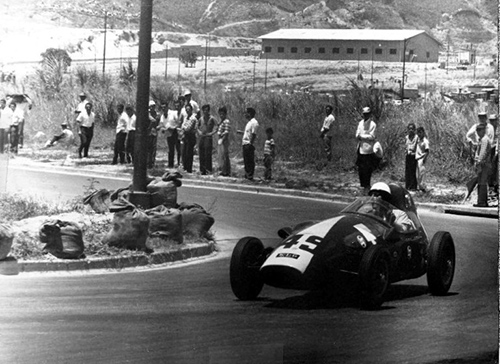
Edy Munõz (#49), Stanguellini-Fiat. (cedits Fulvio Sassi)
The first time that Venezuelan drivers had the opportunity to accelerate the Stanguellinis was a few days after this official presentation, when the cars were taken to the military airfield of Palo Negro (currently known as the Libertador Air Base), near the city of Maracay. The opportunity was great for the teams to get used to the Stanguellinis, which were much more refined machines than the cars that usually contested races in Venezuela.
After this first track day, the drivers had few opportunities to test their machines, as less than two weeks after training in Palo Negro, the first Caribbean Zone Formula Junior race was scheduled to take place. The competition to be contested would be the Premio La Trinidad, which in 1959 was in its second edition.

Lino Fayen (#18), Cooper-Norton 500cc. (credits Dino Turco)
The new Formula Juniors would be the stars of the event, competing for their own trophy, titled Trofeo Rafael Staccioli, in honour of one of the main responsibles for bringing the FJs to the Bolivarian country. Eight cars would take part in the race: the four Stanguellinis from Scuderia La Sorocaima, the two from Scuderia Staccioli, as well as a modified Cisitalia D46, also entered by Scuderia Staccioli, and a Cooper-Norton, entered by Sauro Battistini, but with Lino Fayen as the driver.
The circuit's layout covered more than four kilometers of public roads in the small town of Baruta, on the outskirts of Caracas. The track itself was a challenge for the drivers, because besides being a cramped circuit in the city's small streets, it had several climbs and descents, as well as long straights that ended abruptly in 90° elbows.
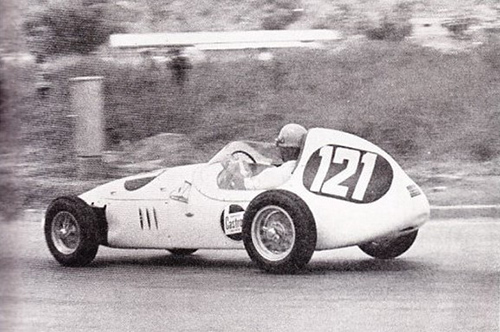
Sauro Battistini (#121), Stanguellini-Fiat. (credits Motor de Venezuela)
After a quick qualifying session, the drivers who performed best were Sauro Battistini (Stanguellini) and Eduardo Munõz (Stanguellini) who shared the front row of the grid. Close behind were Sergio Vivaldi (Stanguellini) and Pablo Mihalka (Cisitalia).
The Formula Juniors were scheduled to be the penultimate race of the La Trinidad racing weekend, which featured several touring car races and other smaller categories. The single-seaters would have to compete 10 laps on the treacherous track, totaling 41km.
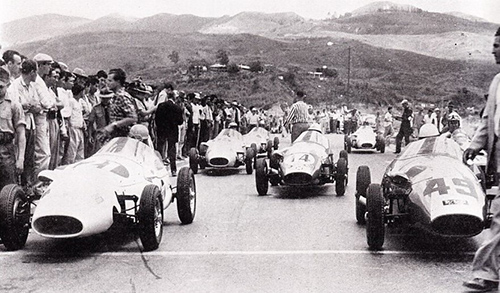
Start of the II Premio La Trinidad. (credits Motor de Venezuela)
Given the start clearance, the cars quickly sped down the main straight of the Baruta circuit. Azzurro Manzini, who started on the third row, made a devastating charge through the field, leading the race at the end of the first lap. Right behind, Lino Fayen, in the Cooper-Norton, was the driver chasing the leader, taking advantage of the agility of the small English car in the tight curves of the circuit.
The two drivers quickly built up an advantage over the rest of their opponents, due to Ladisio Biatnik's accident. The driver, who was right behind the duo, crashed in one of the narrowest parts of the circuit and blocked the track for almost half a minute.
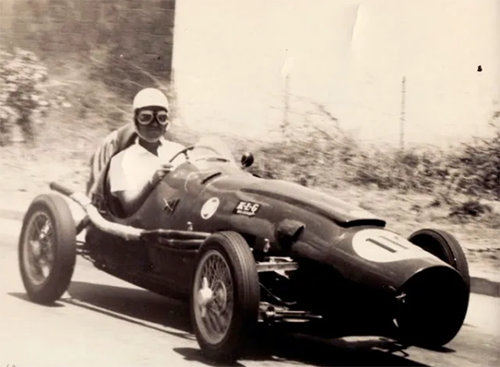
Pablo Mihalka (#119) in the Cisitalia 'El Muletto'. (credits Passion La Velocidad)
As soon as the track was cleared, Pablo Mihalka, on Cisitalia, had risen to third place. Nicknamed 'El Muleto', this car was sent as a 'gift' from the Italians to the Venezuelan drivers, after the purchase of the batch of Stanguellini cars. As far as is known, this vehicle was one of the Grand Prix D46 cars manufactured by the Italian company at the end of the forties, which competed in GP and Formula Libre races till the early fifties, when it was finally declared obsolete.
With the birth of Formula Junior in 1958, Cisitalia saw an opportunity to finally get rid of the remaining D46s and Venezuela ended up becoming the home of at least one of these models. Since the D46 and the Stanguellini shared the same engine (the FIAT 1100 L4), the car only underwent a mechanical checkout before being shipped to the South American country.
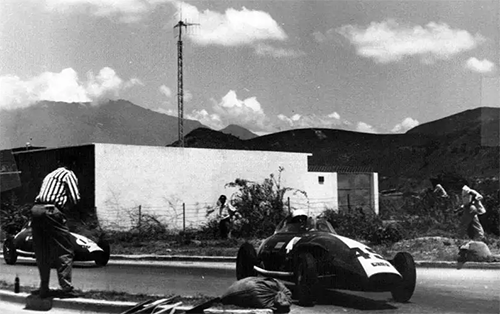
The Stanguellinis tangle with the 4km-long Baruta circuit. (credits Fulvio Sassi)
As incredible as it may seem, the 10-year-old car was still on par with the newer machines. Mihalka really got everything he could out of the D46, holding off Edy Muñoz and Sauro Battistini for a couple laps. However, on the fourth lap, the car showed its age, when one of the connecting rods broke and destroyed the engine of the venerable Cisitalia. It was the end of the race for Mihalka.
Further ahead, Manzini began to set a blistering pace in the lead of the race, causing Fayen to lose ground. Lino began to resent his car – despite the nimbleness of the rear-engined Cooper, which gave it an absurd advantage over the Stanguellinis in the more winding parts of the track, the English car was far behind the Italians on the straights, due to the low-displacement Norton engine.
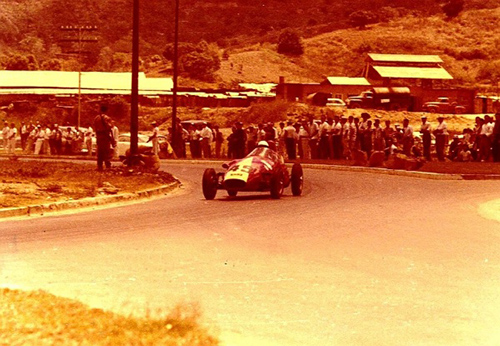
Eduardo 'Edy' Muñoz in his red Stanguellini during the 1959 race. (credits Octavio Estrada)
Not surprisingly, from the second half of the race onwards, Muñoz and Battistini began to get closer to the English car. But the pair did not have the opportunity to offer a moment of emotion to the Venezuelan audience with an overtake, as Fayen abandoned the race on the seventh lap, after the engine's spark plugs failed.
And so, the final positions were delineated, remaining unchanged until the checkered flag. Azzurro Manzini crossed the finish line first, with a race time of 31.25.4, 2 minutes and 10 seconds ahead of second place Edy Muñoz.
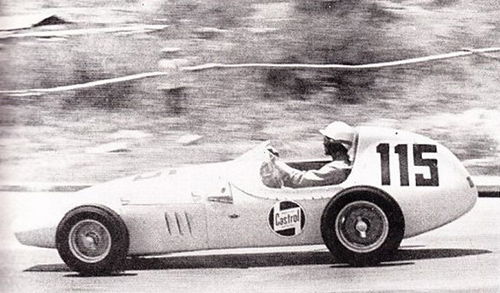
Azzurro Manzini (#115), Stanguellini-Fiat, winner of the race. (credits Motor de Venezuela)
Completing the podium and making a 1-2-3 Stanguellini finish was Sauro Battistini, who had ended up losing contact with Muñoz in the final laps of the race. The fastest lap of the event was set by Sergio Vivaldi, on the 7th lap, in 3.02.04 – the driver finished in 4th position.
1960
Gran Premio de Cuba
- Official name of the Formula Junior race: Gran Premio de Habana & Gran Premio de la Libertad
- Date: February 24 and 28
- Circuit: Columbia Military Airfield
- Lap length: 5200m
- Overall winner: Andrea Melarosa (YV)
- Winning car: Stanguellini 1100
- Engine: Fiat 103 L4
The history of the Cuban GP will always be linked to the infamous events in world motorsport history, mainly due to its 1958 edition, when Juan Manuel Fangio, the most well-known driver at the time, was kidnapped by Cuban revolutionaries at the height of Guevara's and Castro´s guerrillas in the interior of the Caribbean country.
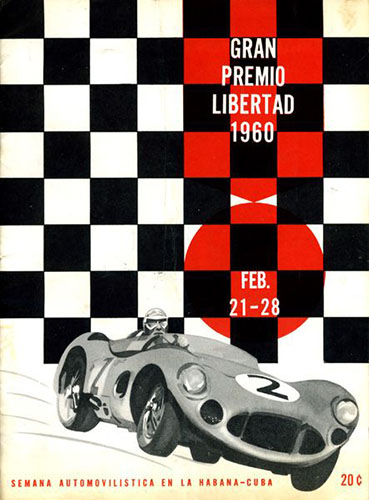
The Cuban Grand Prix's official poster.
But this was just one case of several that marked the history of the troubled GP of Cuba; the three editions of the race (1957, '58 and '60) were surrounded by absurd chaos, mainly due to the unstable situation in the country, in addition to problems that always hovered over the heads of the organisers themselves, who were constantly overloaded with the task of programming and developing a full week of races, in the midst of a civil war.
The story of the Cuban GP begins with the country's interest in further exploring the image of a paradise without rules in the tropics: Cuba was already known as a 'fantasy island' where drinking, drugs and gambling shared the interest of tourists, with the white sands of the Caribbean beaches at the foreground. So, what was the missing ingredient to make the country stand out even more as a destination of international interest? The answer is simple: sports.
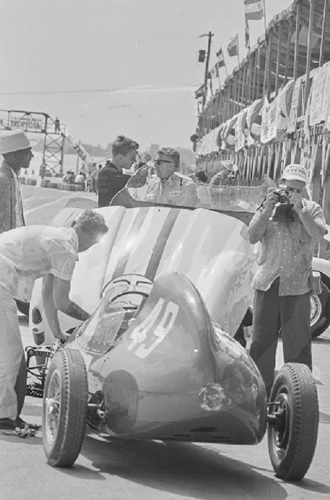
George Constantine working on his engine. (photo Tom Burnside, supplied by the Revs Institute)
And there was nothing as prestigious in sports during the 1950s as hosting a Grand Prix. The glamour and charm of the races, along with their high degree of danger, were what would really draw attention, would give that glorious moment that the dictatorship of Fulgencio Batista so wanted. Furthermore, the race would be a good opportunity for 'neighbourly action' and public relations, dimming the bloody war raging in the interior of the country and overshadowing it with the charm and bright lights of Havana.
The 1957 and '58 editions of the GP, held on the capital's coastal boulevard, despite their mishaps, were extremely well received, mainly by the international automobile community – if you have any doubt about it, just look at the entry lists of both editions. '59 promised to be another great year, as the government and its secretary of sport and tourism strongly wanted F1 to also come, and to be part of the rebranded Cuban Speedweeks (since until now, as mentioned before, the GP was sanctioned only for Touring and Grand-Touring cars).
But this desire was only on paper, as the period 1958-'59 was marked by chaos in Cuba. Fidel Castro's guerrillas were getting closer and closer to the capital, and it didn't take long for the revolutionaries to actually take control of Havana. Because of this, the 1959 edition was canceled indefinitely, until it was decided what would be the fate of the country.

Taking a photo in sunny Cuba! (photo Tom Burnside, supplied by the Revs Institute)
However, 1960 saw the resurgence of the GP, in its last, splendorous form. Fidel Castro, the former guerrilla leader, who now found himself in the role of head of state, soon realised that he would have to give in to certain points of his communist ideology, so that he could begin the process of restructuring the Cuban economy, which was completely destroyed during the long civil war.
Tourism, which until before the start of the conflict was Cuba's main source of income, would have to be re-established, even if it meant that not-so-desirable foreigners spent a few days on the island. And reinserting the GP into the agenda of events would be a great asset, not only in the Caribbean micro scenario, but for the world macro.
Much of the work to re-establish the Cuban Grand Prix was due to the new Director of the Cuban Sports Commission, Captain Felipe Guerra Matos (who was also a revolutionary) and Kenneth 'Ken' Coleman, an active member of the SCCA in Florida. Matos later also delegated part of the organisation functions to Juan Garcia and Alfonso Gomez Mena; they were considered the ideal names, since both had a good experience in racing (for example, Gomez Mena would be the only Cuban to compete in the FJ races, as will be discussed shortly).

Alfonso Gomez Mena at the wheel of his #44 Stanguellini-Fiat. (photo Tom Burnside, supplied by the Revs Institute)
The initial idea was that the race, which until then took place on a single weekend, would be spread over two consecutive weekends, following a scheme more or less the same as the Nassau Speedweeks. For this purpose, it was impossible to use the same circuit as the '57 and '58 editions, due to the problems of readjusting the traffic, in addition to the security issue itself, which was essential for a good image of Cuba and its new regime.
The chosen location was an airstrip, Campo Libertad (also known as Columbia Field), which was located on the outskirts of Havana. The track, which would encompass not only the airport but also some urban streets in adjacent neighbourhoods, was just over 5km (3.11-mile) long and offered a much greater degree of safety than the old route along El Malecón boulevard.
The organisation of this event, which was much better than previous editions, together with these improvements, were some of the factors that allowed Formula Junior to enter the conversations about the Cuban GP. Furthermore, both the category and the Cuban government had complementary objectives, which were perfect for the interests of both parties.

Driver climbing into his car for practice. (photo Tom Burnside, supplied by the Revs Institute)
Since Cuba wanted to improve its image abroad, what better than to invite a category that was gaining great prominence in Europe? And, on the FJ side, Cuba would be an excellent opportunity to expand the category outside the old continent, reaching the markets of the Americas.
Who gave the big push for the FJ to participate in the races in Cuba was Marcello Giambertone, Fangio's friend and agent, but also one of the great enthusiasts of Formula Junior. He was even part of the secretariat of Scuderia Madunina, the team which would play a huge role in the 1960 GP.
After talks between the Cuban government, Kenneth Coleman, Giambertone and FJ leaders in Italy, it was agreed that Formula Junior would indeed be part of the now official 'Cuban Speedweek'. Furthermore, the race would be the opening round of the ANPEC/Auto Italiana d'Europa championship (the country's official Formula Junior championship), which would give more credibility to the event. Even though the FJ didn't have enough prominence at the time to be considered the main event (this would still be reserved for touring cars), it was still an honour to be one of the main events on an international agenda - even more so to a category that was completing its second anniversary of existence in 1960.
In all, 26 drivers signed up to participate in the Formula Junior races in Cuba. The overwhelming majority of cars were Stanguellinis (19), followed by Dagradas (2) and Wainers (2), with Gemini, de Sanctis and Foglietti represented by one car each.
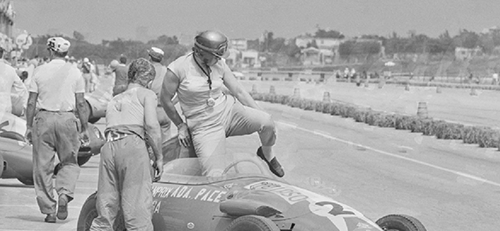
Ada Pace climbing into her #2 Stanguellini-Fiat. (photo Tom Burnside, supplied by the Revs Institute)
The great highlights were the numerous Italians who confirmed their presence in the race: Renato Pirocchi, Giacomo Russo (known as 'Geki'), Roberto Lippi and Lorenzo Bandini, all of whom had achieved excellent results in the 1959 FJ races. In addition, other well-known names in the automobile world appeared, such as Ada Pace, the Italian driver who had enjoyed reasonable success in touring competitions in the late 50s, and the Frenchman Henri Grandsire, who would participate in numerous Formula Junior and endurance competitions in Europe in the 60s.
But the headline always goes to the home driver, and his name was Alfonso Gomez-Mena. The Cuban driver, at the time, already had a good record behind him, especially with touring cars (for example, until the beginning of 1960, the driver had already competed four times in the 12 Hours of Sebring).
The Cuban GP, both for touring cars and for Formula Junior cars, would be divided into two: in the case of FJ, there would be two heats of 30 laps each, with each one having its specific name, its own trophy and counting points for the Italian Championship of the category.
The first heat would be known as Gran Premio de Habana, held on February 24th. Four days later, on the 28th, the second heat would be held, entitled Gran Premio de la Libertad. After completing the two races, the sum of the times would be made and whoever had the lowest joint sum would be declared the champion of the Cuban GP for FJ cars.

Juan Manuel Bordeu in his #8 Dagrada-Fiat. (photo Charly Walmsley)
Since there were several categories in dispute, there was little time available on the track for each one of them to mark their times: In the case of Formula Junior, only on the day before the first race the drivers could have the true taste of the track, when a good time trial session took place on the 5200-meter-long circuit.
'Geki' was the fastest, clocking a time of 2.33.6, and thus securing the best spot in the Gran Premio de Habana. Right behind came Renato Pirocchi and Roberto Lippi, who had set times a little higher than Giacomo's. The highlight was American Peter Carpenter, who was the first of the 'foreigners' in the classification, taking fourth place.
Of the 26 drivers, 21 set qualifying times on Saturday. According to the rules, the five cars that did not participate in the session would start in the last positions of the grid. But that would not be a problem, as none of those cars that lost the session actually lined up on the grid on the race day. So, on another hot afternoon in the Caribbean country, at around 1pm, 21 drivers were ready for the first valid race for the Cuban GP.
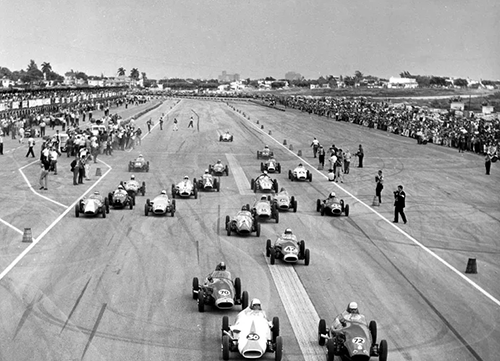
Start of the race. (thanks to Autosport Nostalgia Forum)
The race was marred by the grid's attrition rate, as only 13 of the 21 starters finished the race. Giacomo Russo, who had been the fastest driver in qualifying, had a poor race, finishing only in seventh position. You can take some of the blame away from the Italian driver, as not only him, but his entire team, had a bad GP in Havana. Scuderia Madunina, which in addition to Geki, had taken seven other drivers, with the best qualified driver being Frenchman Jacques Calés, who managed to snatch third place.
Roberto Lippi was another unlucky driver , as his De Sanctis-Fiat overheated on lap 19, forcing the Italian to retire from the race. Therefore, who capitalised on all these problems was Renato Pirocchi, who dominated the Gran Premio de Habana practically from start to finish.
Pirocchi made an almost exemplary appearance; for example, after finishing the last of the thirty laps of the race, the Italian had opened almost a minute of advantage over his closest pursuer, Peter Carpenter.
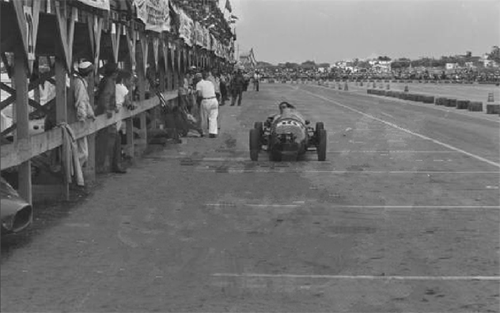
Roberto Lippi retiring his #18 De Sanctis-Fiat to the pits. (photo Tom Burnside, supplied by the Revs Institute)
After the FJs came the touring car competitions, which also provided great entertainment to the public. Only after those were finished the drivers had the chance to enjoy the island in the heart of the Caribbean, during a week of ease and peace. But the beaches and drinks quickly gave way again to asphalt and driving; it is worth remembering that the drivers had not gone to Cuba for pleasure, but for work!
The Gran Premio de la Libertad would be disputed in the same formula as the Gran Premio de Habana, held less than a week before: 30 laps on the Columbia Field circuit, totaling approximately 156km per heat. The one who surprised this time in qualifying was Lorenzo Bandini, who finally managed to demonstrate to the Cuban public why he was regarded as one of the greatest promises of Italian motorsport.
Once again, not all the entered cars lined up on the grid. Even so, the race was still exciting on that February 28th. Scuderia Madunina looked like it had recovered from their first race shock, as now four of their cars were in the top 10.
The same protagonists of the first heat were repeated in the second, with the exception of Bandini, 'Geki' and Calés disputed the first positions, followed by Venezuelan Andrea Melarosa. Meanwhile, Roberto Lippi was once again struck by bad luck, finishing the race in the 13th position, five laps behind the leaders.
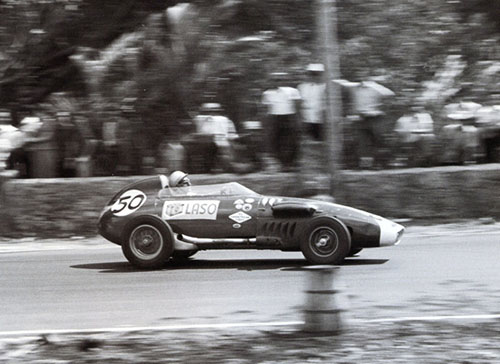
Lorenzo Bandini leading the race in his #50 Scuderia Madunina Stanguellini-Fiat. (credits unknown)
And speaking of the leader, Lorenzo Bandini had an extremely comfortable race. Apart from the backmarkers along the way, the Italian didn't have any trouble crossing the finish line of the Gran Premio de la Libertad in first place. Right behind came 'Geki' and Melarosa, completing the podium of the heat.
Unlike the first race, however, the race on the 28th was not a clear domination of the Stanguellinis. While in the Gran Premio de Habana the best non-Stanguellini finished in 10th place, with Duncan Forlong and his Gemini Mk2, in the Gran Premio de la Libertad, Angelo Bianco finished fifth with a Dagrada.
But after celebrating the Gran Premio de la Libertad, it was time to declare who was the overall champion of the GP of Cuba. And the winner was… Andrea Melarosa, with a combined total of 2h39'59.5". But it wasn't easy for the Venezuelan driver, as Frenchman Jacques Calés was just 4s off Andrea's combined time.
In this case, however, Melarosa was rewarded for his regularity: a fourth place in the first heat, together with the third in the GP de la Libertad had been enough to give him the title of the 1960 Cuban GP for Formula Juniors.
VII Annual International Speedweek of the Bahamas
- Official name of the Formula Junior race: Pan-American Race
- Date: November 27, December 3/4
- Circuit: Oakes Field
- Lap length: 7240m
- Overall winner: Jim Hall (USA)
- Winning car: Cooper T52
- Engine: BMC ‘A’/Speedwell
The end of year was approaching and with it, the most traditional event in Caribbean motorsport: the Bahamas Speedweeks. The races, which usually took place between the end of November and the beginning of December on the island of New Providence, or, more specifically, in the capital of the Bahamas, Nassau, were heading towards its seventh edition, with a success and prestige that only increased year by year.
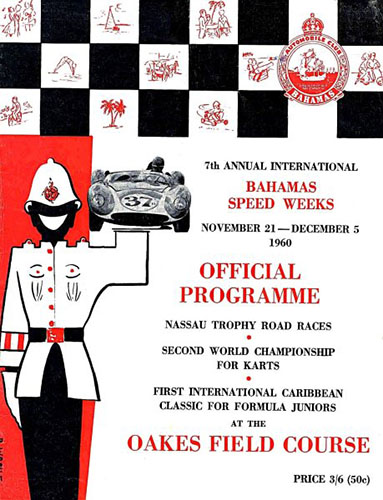
The official poster for the 7th Bahamas Speedweek.
The Speedweeks had a troubled start in 1954, due to the disagreement that existed between the Nassau organisers and the FIA, which was totally opposed to the event being held. Nothing that could stop the dream of Sherman 'Red' Crise (the main figure behind the creation of the Speedweeks), who individually continued the endeavour of setting up a real GP in the Bahamas.
Even if the most European competitors declined the invitation to participate in the first edition, as the FIA. threatened to withdraw the licenses of any affiliated driver participating in that race, it was impossible for the world motorsport organisation to mask the success of the first edition of Speedweek.
Therefore, the success of the first edition was largely due to the reasonable number of drivers from the US, Mexico and other countries in the Caribbean region that attended the race, in addition to the support of the Royal Automobile Club (since the Bahamas were still British territory at the time) and the American Automobile Club, with the SCCA also making its contribution.
Seeing how wrong their first position was, it wasn't long before the FIA went back on its initial decision, promising that for II Speedweek, the organisation would give full approval to the event. And the promise was indeed fulfilled, allowing it to grow to such magnitude and scale that, until the late 1950s, the race was basically considered the official end of the global motorsport season.

R. Neilson entered an Elva-DKW 100. (credits The Henry Ford Museum)
Another factor that allowed the rapid expansion of Speedweeks was its tourist appeal, as this was of paramount importance for the economic development of the Bahamas. The islands were already one of the favorite destinations for tourists, especially North Americans, who sought to escape the approach of winter and the freezing cold of November and December.
During Speedweeks, tourism to the islands typically grew at levels 65-70% higher than at any other time of the year. This was what united the newly created Bahamas Automobile Club and the Bahamas tourism and promotion departments in a common objective.
The editions between 1958 and 1963 were the peak of the Speedweeks, since it was during those years that the big car manufacturers and brands participated in the event: Ferrari, Maserati, Porsche and other giants began to send almost professional teams to the Bahamas, throwing to the sidelines most of the privateers that, until now, had set the tone for the most prestigious trophies.
In this way, as Speedweeks gained more and more importance in the international motorsport scene, it was almost a natural process for single-seater racing to be added at one time or another to the Speedweeks roster, complementing the already bloated number of car races. So it wasn´t a surprise when Formula Junior was announced to be part of calendar for the 1960 edition.
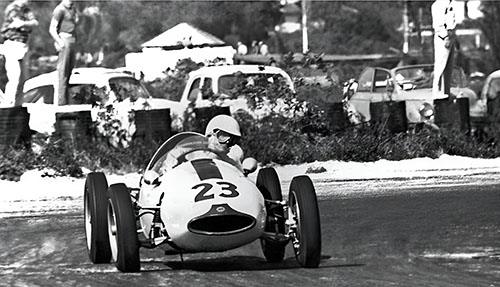
H. Humphries brought his Cooper-BMC T52 to Nassau. (credits Ferret Photographics)
Many of the FJ cars that would participate in the races in Nassau had little in common with those that had competed in the last official Formula Junior race in the region, in Cuba, in the month of February. The rear-engined Lotus and Elvas had replaced the front-engined Stanguellinis as the most numerous cars on the grid. This was due to the single-seater revolution, which was only now beginning to take effect in categories below F1.
In this case, no less than ten manufacturers would be represented in the 1960 Formula Junior racing series in Nassau: in addition to the aforementioned Lotus, Elva and Stanguellini, there were cars from Cooper, Volpini, Gemini, VW, Scorpion, Dagrada and Osca, all of them with their own specifics, virtues and weaknesses.
It was decided that Formula Junior would compete in two races: the first would be valid as a Nassau Grand Prix, and would be divided into two heats (which would take place on November 27 and December 3), with five laps each. The second part of the series would take place on December 4, which would receive the pompous name of the Pan-American Race. It would be the desired prize, because in addition to being a separate trophy, it would be the last stage of the SCCA Southeast Division of Formula Junior championship.
The first race scheduled for Sunday the 27th was a day of mixed feelings for followers and believers of rear-engined cars in FJ. Even though the victory went to the American Pat Pigott and his Lotus-Ford 18, it did not come as easily as expected, largely due to the talent of the brothers Pedro and Ricardo Rodriguez.
The two Mexicans made Pigott fight hard for the victory during all five laps of the heat, not allowing the American to use the best qualities of the Lotus at any moment. It's no wonder that with significantly inferior cars (Ricardo was equipped with an Osca, while Pedro had a Scorpion), the two finished a few seconds behind Pigott's Lotus.
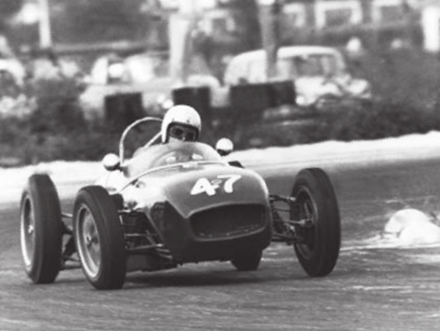
Pat Pigott romping to victory in his Lotus-Ford 18. (credits Ferret Photographics)
Even so, it should be noted that of the top five classified, only Pigott had a rear-engined car. This is also due to the fact that some of the main drivers chose not to participate in this heat, with the intention of preserving their cars as much as possible for the following weekend's races.
But a week of peace and tranquility in the Bahamas would be more than enough to lift the spirits of the most restrained ones, and, for the 3rd and 4th, all the drivers found themselves confident of disputing to the fullest the remaining Formula Junior trophies.
First, it was up to finish the Bahamas GP race, performing its second heat. 16 cars lined up for what would be the first true test, the first taste of what Sunday could reserve. Furthermore, it was important to get the best possible position in this race, since there was no more time for qualifying heats; so, the final result would be used to assemble the grid for the Pan-American Race.
And that second heat didn't disappoint: Pat Pigott, Harry Carter, H. Humphries and Charlie Kolb quickly stood out, with Kolb taking the top spot. Pigott was in direct pursuit of the Elva driver, with Carter and Humphries fighting each other for third position.
On the second lap, however, Kolb suffered a mechanical problem, which made the first position fall into Pigott's lap. And, obviously, the driver did not deny this gift, managing, after that, to open a small advantage over his pursuers in the following laps.

Charlie Kolb challenged for wins in his Elva-DKW 200, but proved unlucky. (credits Ferret Photographics)
Pigott calmly crossed the finish line in first place, with Carter and Humphries in second and third positions, respectively. More important than winning the first two races and securing the number 1 position on the starting grid for the race on Sunday, Pigott demonstrated that he was the driver to beat in the first edition of Formula Junior in the Bahamas. Could anyone face off the American?
That question could only be answered on the track, and the next day everyone was looking forward to the FJ's big final race at Speedweek: all 20 drivers were finally ready, with the machines being rolled to their respective starting positions.
When the flag was lowered, Harry Carter took the lead, relegating Pigott to second place. Jim Hall was right behind in third, and Charlie Kolb, who wanted to repeat his good initial participation in the previous day's race, already took fourth spot.
Hall was the one who best took advantage of the inherent chaos of the first lap because, when on the opening of the second, the American and his Cooper T52 had already risen to first place. Pigott still held second, as Carter committed a mistake and had lost several positions.
Pigott and Hall quickly demonstrated that they were in a race apart, as lap after lap, their advantage increased over the rest of the field. Meanwhile, the pack was slowly being broken down: between laps 1 and 8, eight of the 20 cars abandoned the race, mainly due to mechanical problems related to the heat and the salty sea breeze from the Bahamas, which were fatal to the machines.

Harry Carter took an early lead in his Lotus-Ford 18. (credits Ferret Photographics)
Hap Sharp was another driver who began to stand out in the race: Sharp, who had borrowed a Lotus 18 from Hall just for this series of races, remained among the top positions, managing to enter the podium close to the fifth lap, when Kolb once again had problems with his Elva.
But Sharp only saw his gap to Hall and Pigott gradually increase, until there was no longer any chance of catching up with the leaders. And even among them the pace had picked up, especially on Hall's side. The American and his Cooper put in some spectacular laps, as Pigott now struggled to keep up. Hall didn't give his closest rival any chance, finishing the twenty laps in 38.01.43, thirteen seconds ahead of Pat Pigott. Third came Hap Sharp, after a consistent and error-free race made by the Lotus driver. Harry Carter finished a step away from the podium, in fourth place, after a good recovery race.
In this way, the Lotus and Coopers reaped the laurels of victory, leaving the Italian machines in the dust – because, until then, they were the 'owners' of the circuits. 1961 was already on the horizon, and with it, another year of changes and transformations.
1961
VIII Annual International Speedweek of the Bahamas
- Official name of the Formula Junior race: Pan-American Race
- Date: December 8/9/10
- Circuit: Oakes Field
- Lap length: 7240m
- Overall winner: Pete Lovely (USA)
- Winning car: Lotus 20
- Engine: Ford 105E
Almost a year went by before a real Formula Junior race came again to the Caribbean islands - and the place where it would take place could not be better: Nassau. The scenario could be the same as the last edition, but certain changes on the infrastructure of the venue promised that the 1961 Speedweek would be the one, if not the most, professional ever held.
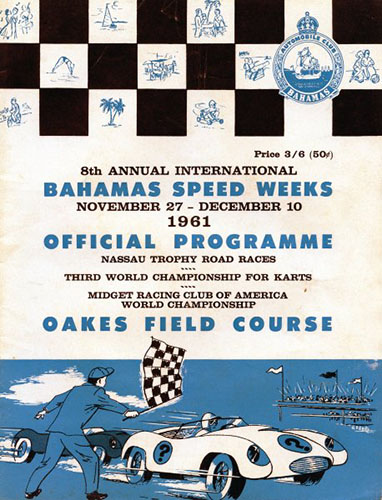
The official poster for the 8th Bahamas Speedweek.
This is due to a series of decisions taken by the organisers, including Sherman 'Red' Crise himself, which were based on suggestions from the participants of past editions. The first was the re-asphalting of the entire surface of the runway, since a good part of the site still used the original pavement of the airfield converted into a race track.
According to the drivers, the track conditions were so precarious that the touring cars suffered from bumps, even causing parts to fall from the vehicles. So, it is worth thinking, if the most robust cars like the Ferraris and Maseratis GTs suffered with the surface, what the sensitive FJ had endured in the 1960 edition!
Another concern was the need of greater professionalisation of everyone involved with the circuit's activities, especially track marshals and other teams that were directly involved with the races.
With the exception of a few representatives from the Royal Automobile Club (RAC) and the Sports Car Club of America (SCCA), who came to the island mainly to help with the timing sessions, there was no other sign of professionalism in areas concerning the circuit. For this, the Bahamas Racing & Sports Car Club was created, with the aim of establishing a more professional body of track marshals, incorporating the most experienced volunteers from previous races.
But it wasn't just Oakes Course that brought changes for 1961. Formula Junior also wanted to be part of this revitalisation process, and this could be observed both in the machines and drivers that would compete in this year’s series of races.
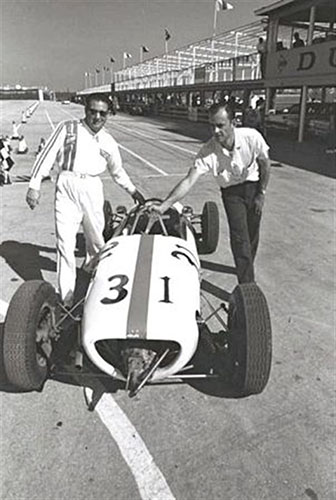
Rodger Ward turned up in his Merlyn-Ford MkIII. (credits unknown)
The impressive line-up, which featured names like Mark Donohue, Pete Lovely, Roger Penske and Rodger Ward, would certainly elevate Formula Junior racing to another level, as they were much better known names to the public than most of those who had competed in the trophy in 1960. Furthermore, almost all the cars that had been entered in the race were rear-engined, making it clear that front-engined machines were a thing of the past (to be precise, only two front-engined cars would compete in the 1961 Pan-American Race).
Due to the success of the 1960 edition, the dispute scheme would again be repeated in two trophies: the first would be a symbolic GP of the Bahamas, divided into two heats of five laps each. After these, the decisive race would be held, the Pan-American Race, with one full 12-lap race.
Even before the races began, there was a lot of emphasis on the drivers who would compete for the award, as a way of publicising the category that was also developing fast in the USA: Mark Donohue was still far from the fame that would embrace the driver in the early 70s; a decade earlier, however, Donohue was still a rising star, having recently won one of the SCCA's national championship divisions. Donohue would take to the Bahamas an Elva 300, a brand-new car that cost him $6000.
Pete Lovely and Roger Penske already had more consolidated careers in motorsport, having even participated in Formula 1 races in previous years. Lovely was equipped with a Lotus-Ford 20, the best Formula Junior car a private driver could buy. Meanwhile, Penske would have at his disposal a Cooper-BMC T56 Mk2, which was simply an evolution of the 1960 model (the Mk1) that was still proving to be very competitive against the ever-increasing army of Lotus FJs.
In the case of Rodger Ward, the appearance of the champion of the 1959 Indianapolis 500 was a more than welcome surprise for the organisers. Theoretically, the driver wasn't even supposed to race at Nassau that year, but an opening came up, when Bill Fuler (a recurring driver in SCCA California region circles) was unable to attend the event. So, with a seat open for one of the Merlyn Mk3s of the Flanery Racing Enterprise, Ward couldn't refuse the invitation to race in the Bahamas.

Start of one of the heats. Drivers are Roger Penske (#85), J. McAfee (#88), Pat Pigott (#15), Pete Lovely (#65), Jim Hall (#66) and Charlie Kolb (#68). (credits J. Owen, Terry O'Neil)
The two Nassau Trophy races for Formula Junior cars had been scheduled for December 8th and 9th. As always, it was sunny and very hot on the circuit, which was really an uncomfortable situation, especially for the machines. As it was in the 1960 edition, some of the drivers decided not to participate in the first two Formula Junior races, seeking to prevent any damages to their machines before the Pan-American Race.
The consequence of this was that the grids were very lean in the two heats valid for the trophy. In the first, the great highlight of the 1960 edition, Pat Pigott, now updated with a Lotus 20, overshadowed all the big medallions on the grid, when the driver stole the first position from his opponents in the initial laps - to not lose it anymore during the race. J. McAfee came in second, with Roger Penske in third.
The second heat the next day was a little more in line with what was expected to happen: Pete Lovely and Roger Penske imposed a greater challenge to Pigott's dominance this time, making the small skirmish between the three last for the next five laps. The battle between the two Lotuses and Cooper only had its solution on the last lap, when Lovely pushed harder than ever and left his two opponents behind, crossing the finish line first, with an average speed of 87.7mph.
Roger Penske, on the other hand, managed to hold off Pigott's pressure, achieving a great second place in his Cooper. The results in this second heat were essential for the drivers who wanted to win the Pan-American Race, because, once again, due to the tight schedule, there was no time to schedule a timekeeping session. Thus, the results were recycled for the formation of the grid of the race on the following day.
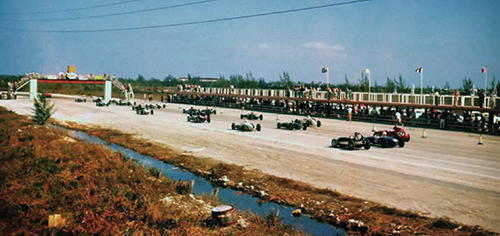
Looking at the grid from the back. (credits J. Owen, Terry O'Neil)
21 cars lined up at the Oakes Course on the 10th, for the grand final of the American Formula Junior, held under the Pan-American Race trophy. The Merlyns were finally added to the Lotus, Coopers and Elvas as an official part of the grid. This is because in the previous two races, the Flanery Racing Enterprise cars had been plagued with transmission/gearbox problems, which had confined both cars to their garages for the previous two days.
But now there was no other option: it was all or nothing. And the drivers soon tried to accelerate as much as they could as soon as the clearing signal was given: first by Symonette's Straight, making the British Colonial Loop turn and heading towards the great Sassoon Straight.
It soon became clear that the protagonists of the previous day would be the same in this race: Pigott, Penske and Lovely again began to open a comfortable lead over the rest of the closest chasers, a small group that was composed of Hap Sharp, Mark Donohue, Bob Nethercutt and Jim Hall. Speaking of which, the champion of the 1960 Pan-American Race was not having an inspired weekend, having finished both heats of the Nassau Trophy in eighth and fifth.
Further back, the Merlyns had serious problems trying to keep up with their opponents, culminating the team's misadventures with the accident of Rodger Ward on the second lap. The driver lost control of the car a little after the Crisis's Corner and ended up only in a protection fence, on the margins of the circuit.
The official blame for the accident was directed to the Hewland gearbox, which had been suffering from several failures throughout the weekend. Now, the 'unofficial' explanation was that the driver was not used to making turns to the right (since, curiously, the turn Ward crashed was to that side), taking into account that Ward built almost his entire career on USAC's oval circuits.
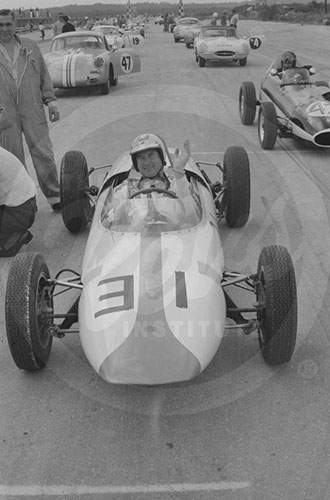
Rodger Ward in the #31 Merlyn-Ford MkIII, on the right side corner you can see the #42 Stebro MkI driven by Peter Broeker. (credits Albert R. Bochroch Photograph Collection & the Revs Institute)
Meanwhile, further ahead, the fight between Pat Pigott, Roger Penske and Pete Lovely became more selective, as Penske's Cooper began to fall behind. Pigott and Lovely turned the dispute into a personal duel, as the only cars in front of them now were the latecomers.
Even if Penske was losing some ground, the driver had already secured a comfortable advantage over the midfield, which now only had Mark Donohue and Bob Nethercutt as the main representatives.
In the final laps, the battle between Pigott and Lovely heated up even more, as the two disputed wheel by wheel who took the lead. Taking advantage of a gap left by his opponent, Lovely took the lead with a couple laps still to go. But that wasn't the end of the confrontation, which lasted until the chequered flag, with Pete crossing ahead of Pigott with just a few seconds of advantage.
Right behind came a calm Roger Penske, who finished the race at a cruising pace, only guiding his car to a well underway third place. Completing the top-five were Donohue and Nethercutt, with the rest of the cars already far behind in the standings.
The Caribbean once again proved that it could be a good place for Formula Junior racing: hard-fought races, with balanced cars and drivers that in addition to providing beautiful battles had a significant appeal with the crowd, which is great both for the sporting aspect, as well as the commercial. 1962 would be Formula Junior's last year in the Caribbean and with it would come one of the most peculiar events of the category throughout its ephemeral existence.
1962
I Puerto Rico Grand Prix
- Official name of the Formula Junior race: Trofeo Corazón
- Date: November 9
- Circuit: Antilles Auto Racing Circuit (Cáguas)
- Lap length: 2736m
- Overall winner: Tim Mayer (USA)
- Winning car: Cooper T59
- Engine: BMC A
The concept behind creating a Grand Prix in Puerto Rico might be pretty suggestive, but it wasn't unrealistic at all. The island that was one of the main destinations for American travelers in the Caribbean region also wanted to capture its share in this new type of tourism, focused on motor racing.

The official poster for the 1962 Puerto Rico GP.
Puerto Rico was also quick to realise that it too could enjoy this movement, putting together a rough draft of what was expected to be one of the biggest racing events in the region for years to come. Much of this idea was based on the experience of the Nassau Speedweeks, which were at their peak in early 60s. So, there wasn't much discussion about it, as it was clear to everyone that the example of the Bahamas was the best one to follow, as it presented itself as an extremely successful business model.
The island had already hosted a number of smaller races, in the regions of Aguadilla and in San Juan itself, mostly with a mix of local drivers and some Americans. But these could not even be considered official events, since they all took place in extremely precarious situations of organisation and security. However, for 1962 this would be different: preparations would be made as professionally as possible.
The first step was to establish an organisation that could handle a larger event like a GP. This began to be shaped by David Ash, an affiliate member of the SCCA and chairman of the West Nyack, NY-based Grand Prix Societé de Puerto Rico. Ash recruited several SCCA members across the country for the project, mainly from the Southeast Division (which spans from the Carolinas to Florida), so that they could organise all the technical and physical aspects of the event.
The original plan began to be drawn up in the mid of 1960, with Ash and his associates seeking to establish a chain of stakeholders, initially among sponsors. Little by little, a solid network was established, made up of the Puerto Rico tourism department, local hotel associations, and certain global commercial giants, such as Esso and Coca-Cola.
By mid-1961, the initial work had been completed, with over $20,000 in funds raised to run the GP (and, by the time it was to be run, this value has been raised to roughly $150,000, something around $1,518,000 in 2023). Now it was time to start the practical work, which involved the structure of the event.
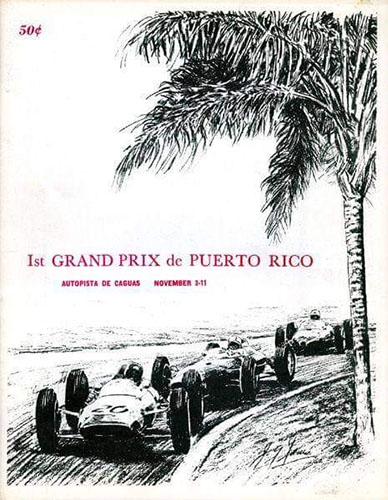
The programme.
So, the second point was to choose the date for the race, and this would be a fundamental question, since the calendar was tighter than ever. It was known that the race would have to take place at some point between October and March to attract the best-known drivers, as it was during these months that they 'visited' the United States or Mexico. Furthermore, these months represented the high season for tourism in the region, which was itself a delimiting factor for the event.
Speaking only from the sporting perspective, between 1962/63, most of the months already had a huge event: the US GP (October), the Mexican GP (November), the Nassau Speedweek (December), the inauguration of the Daytona circuit (January and February) and the 12 Hours of Sebring (March), plus several other small races throughout the region. This made it very difficult to insert a new event into the calendar, which was already quite overstretched by regional standards.
The final decision of the organisers was to schedule the event between the 3rd and 11th of November, that is, almost on the same time as the 1962 Mexican Grand Prix. This, according to the organisers, would motivate some of the drivers who attended the Mexican national GP race to go to Puerto Rico straight away, allowing the most important drivers to attend the most acute and important phase of races on the island.
No wonder that right from the start a pompous list of drivers began to appear on the lips of the media and the public: Stirling Moss, Bruce McLaren, David Piper, Jean Guichet, Jo Bonnier, Dan Gurney, Roger Penske and the Rodriguez brothers were all on the first list released to the press.
There were other issues still pending and that should be solved as soon as possible. The most alarming situation was the location of the race: it was soon found out that it was impossible to use any of the old venues, as they were totally unsuitable for the task of hosting such a widely publicised GP.
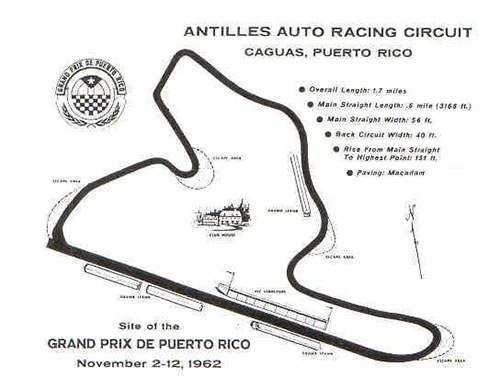
The lay-out of the Cáguas circuit.
Therefore, building a venue solely and exclusively dedicated to racing became the GP's central theme. A town called Cáguas, about 35km from San Juan (the country's capital) was considered as the perfect place for the construction of a race track; and, it didn't take long for a 2,736m-long circuit to emerge at the site.
At a cost of almost half a million dollars, the Caguas circuit was not a work of human primacy, nor did it have a 'flow' that would create appeal for the big races that were expected there (mainly due to the absence of straights and places that the cars could develop a greater speed). Even so, the track was still a challenge for cars and drivers.
If it wasn't enough to build a circuit between a sugar plantation field and the island's native forest, the track was extremely hilly, as its location was in a small opening the middle of the Sierra de Cayey. Therefore, it was not surprising that ¾ of the bends and kinks had blind spots.
In addition, since the circuit was located in the heart of the country, between forests and mountains, it was common for torrential rains to routinely sweep the place. This, in combination with poorly done asphalting work, generated an extremely slippery and abrasive surface, which further hindered the best performance of machines and drivers.
That was one of the first factors that started to raise doubts in the minds of the drivers, about the viability of running a GP on the island. Furthermore, another sequence of external factors, which were beyond the control of the organisers, would take its toll, basically throwing the meticulous planning of the Puerto Rico GP into the trash can.
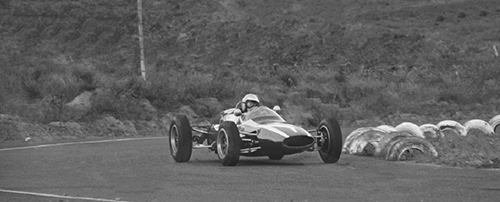
Tim Mayer led proceedings in his Cooper-BMC T59.
(credits Albert R. Bochroch Photograph Collection & the Revs Institute)
The Cuban Missile Crisis that would last almost the entire month of October was a very hard blow to the GP, with several drivers concerned about the insecurity and instability in the region. At the time, almost 25% of the 80 registered international drivers claimed that this situation made them abandon the idea of participating in the GP.
Furthermore, much of the race's appeal was lost as many of the great stars started to rethink the idea of going to Puerto Rico. And, in the end, most of them opted to not attend the event. Besides that, some drivers had other problems that prevented them to go: Moss had suffered a terrible accident at Goodwood earlier in the year and was still not fit to drive again. Ricardo Rodriguez was the victim of a fatal accident at the Mexican GP, causing his brother, Pedro, to refuse to participate in the Puerto Rico GP.
Formula Junior, which was one of the main attractions of the event, also suffered from this process of uncertainty that surrounded the GP in its preceding weeks: there were talks for Bruce McLaren to participate in the category's race, but these cooled down as the time went by, as it became increasingly clear that the race in Puerto Rico was doomed to fail.
But this was the good side of Formula Junior: the category always managed to put on a show, even in the most difficult conditions. For Puerto Rico, there were just over half a dozen entries for the category; that is, an almost negligible number of competitors, for a race that was expected to be a challenger at the height of the Nassau Speedweeks.
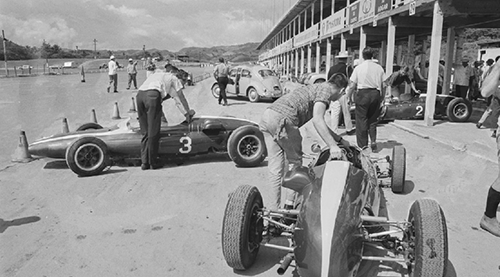
The pits of the RevEm team. (credits Albert R. Bochroch Photograph Collection & the Revs Institute)
And the organisers should have thanked a lot the RevEm team, who managed to bring three Coopers to the race. The team that began in early 1962 as an amateur venture between Peter Revson, Timmy Mayer and Bill Smith soon became a more professional endeavour. This was reflected in the excellent performances achieved by the team in the US Formula Junior series of 1962, which culminated in Tim Mayer's national title in the category late in the year.
With this growing professionalism, Teddy Mayer quickly took over the operational control of the set. For Puerto Rico, the drivers who would participate in the race would be the 'owners' of the team themselves: Peter Revson, 'Tim' Mayer and Bill Smith Jr.
In addition, there were only three more FJ cars that actually showed up to compete in the race: two of these belonged to the Dietrich team, formed by Chuck Dietrich and his wife, Suzy. The Dietrich couple was undoubtedly the most experienced team on the grid. Chuck had been an amateur racer since the early 1950s, while Suzy officially entered the SCCA books in 1953. For this race, Chuck would drive an Elva-Ford 300, while Suzy would try to do her best in a Cooper/BMC T59.
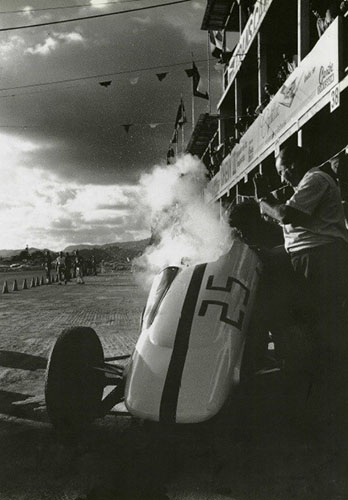
Hugh Dibley's Lola seen smoking in the pits. The pic was probably taken after the driver's spin on lap 20.
(credits Tom Burnside Collection)
Hugh Dibley also did his laps at the Cáguas circuit, being the only representative of his team, Scuderia Light Blue. The driver would have a Lola-Ford Mk 5 at his disposal, a car that was a clear evolution compared to the previous models of the English constructor (the Mks 3 and 4).
The Formula Junior race was scheduled to happen only on the 9th, two days before the official end of the Puerto Rico GP. After the FJ race, there would only be another few races, before the definitive Grand Prix, exclusive to Grand Touring and GP cars (in other words, nothing more than a race with Formula Libre regulations).
The Trofeo Corazón (as the FJ race became known) would be contested in a single heat lasting for 45 minutes. It was not very common for single-seater races to be contested based on time rather than a fixed number of established laps, but for organisational reasons, this formula was decided upon.
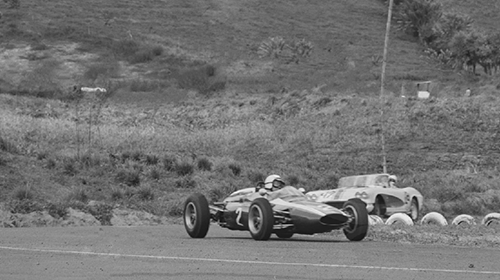
Since the track was new and time was short, it was common for cars from different categories to practice together. Here Bill Smith Jr (#2) in a Cooper-BMC T59 shares the track with a Corvette C1 (#47).
During the qualifying days, it was a common sight on the circuit for cars from multiple categories to be on the track at the same time, as drivers made the most of the opportunity to get acquainted with the track. In addition, due to the meteorological instability of the place, any truce in the rain or dry asphalt meant a swarm of cars on the track.
After a full week of practice in which all FJ drivers left unscathed, Tim Mayer did the best: he would have the honour of top spot on the starting grid. In second and third were Chuck and Suzy Dietrich, respectively. Coming behind, were lined up: 4th – Hugh Dibley; 5th – Bill Smith Jr. and 6th – Peter Revson.
On the 11th, the weather in Cáguas was not very friendly. Thick clouds covered the highest points of the Sierra de Cayey, with only a sliver of sunlight momentarily showing here and there. The threat of rain was constant, but even that couldn't cancel the race at that point. It was in this scenario that the six cars lined up for Trofeo Corazón of Formula Junior.

Fangio and his habit of appearing in the least expected places. (credits Tom Burnside Collection)
And who would waive the green flag for this race could not be anyone other than Juan Manuel Fangio himself! Even though this may sound strange, it happened because Fangio was one of the biggest promoters of motorsport in Latin America and the Caribbean, always encouraging the emergence of new races in places where a professional event had never been held.
The starting sight was given, and going down the main straight of Cáguas, Tim Mayer soon tried to secure his first place, with Chuck Dietrich close behind. Suzy, who had performed so well in the qualifying sessions, had a problem right at the start, when her car refused to move. The driver quickly discovered that there was a problem with the car's first gear and, only after managing to accelerate in second gear, was she able to leave the starting straight behind.
Dibley, who started fourth, was the one who made the most gains at the first lap. Due to the failure with Suzy's car, the driver had already moved up to third and, at the end of the lap, this position had already evolved into first, after a quick and daring manoeuvre over both Tim Mayer and Chuck Dietrich, in the first curve.
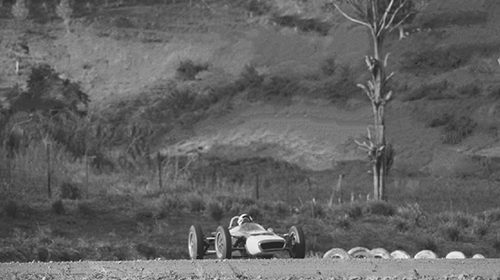
Chuck Dietrich in his #34 Elva 300. (credits Albert R. Bochroch & the Revs Institute)
Dibley, however, didn't take long to realise that there was something wrong with the car. Even though he held first position, the driver did not feel comfortable with his situation, and not surprisingly, since the Hong Kong driver's car was suffering from a sheared bolt in the steering mechanism. Therefore, on the second lap, the driver began to lose the pace and both Mayer and Chuck re-overtook the driver with ease.
Even so, the driver valiantly continued to keep the car on the track until the 20th lap, when the front trailing arm bolt finally broke. As a result, the driver lost control of the car and spun on the Bamboo curve. Even though the accident was light, with the car leaving almost unscathed, there was no way to return to the race - Dibley's Lola proved to be the driver's Achilles heel.
Therefore, the first position had fallen into Mayer's lap. Right behind was a constant Chuck, who hoped to get a place on the podium in that very peculiar race. But this desire did not last long, as on the same lap as Dibley´s accident, Dietrich's Elva overheated, forcing the driver to an unscheduled stop in the pits. In this way, the other two RevEm cars that were behind quickly took over the positions, almost guaranteeing the 1-2-3 on the podium for the team.
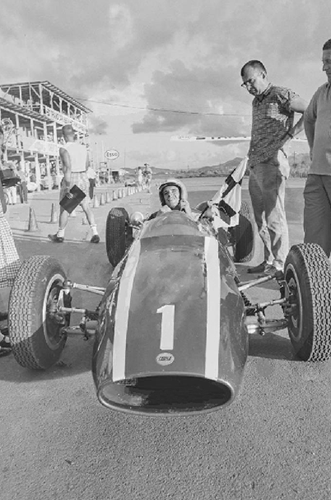
The first and only winner of a Formula Junior race in Puerto Rico - Tim Mayer.
(credits Albert R. Bochroch & the Revs Institute)
So, the race basically became a RevEm procession for the next few laps: Tim Mayer in first, with Revson and Smith taking turns for the two remaining podium positions. Well behind came Chuck and Suzy, who now only had an interest in finishing the race. In the final laps, the last movement of the race happened, when Smith definitively took the 2nd position, relegating Peter Revson to the third.
In a race almost dominated by Coopers, Tim Mayer made history, winning the only single-seater race in Puerto Rico to this day. With an average speed of almost 120kph, in addition to winning the coveted Trofeo Corazón, the driver took home a prize of US$1000.
IX Annual International Speedweek of the Bahamas
- Official name of the Formula Junior race: Pan-American Race
- Date: December 7/12
- Circuit: Oakes Field
- Lap length: 7240m
- Overall winner: Rob Nethercutt (USA)
- Winning car: Lotus 20
- Engine: Ford 105E
Another year was approaching its end, and that meant it was time to go back to the Bahamas. The 1962 Speedweek would once again feature Formula Junior on its programme, presenting the crowd with a show that would never be repeated again on the island. Well, it could not be known at the time, but the 1962 edition would be the last to feature the charismatic FJ cars.

The official poster for the 9th Bahamas Speedweek.
This was due to the high costs that were now starting to impact Formula Junior events around the world. 1961 was a transitional year for the category, when it almost 'officially' replaced F2 as the previous step to Formula 1. But only 1962, however, is that the impacts of this change were really felt, since the level of professionalism in the category rose sharply, while many teams and drivers, who were almost entirely amateurs, were stagnant in their places. And, unfortunately, it was now too late to reverse the tide of events.
In addition to the drivers, the main ones affected by this category's fast developing process were the race organisers: if before the FJ was a simple and reasonably economical solution to have a single-seater race, 1962 demonstrated how economically impracticable it was becoming to host these races, even with an appeal greater than ever before. It was obvious why: more professionalism means better cars and drivers, higher spending on organisation and safety, and higher prizes. The problem was that money was not in abundance for 80% of the venues that hosted a Formula Junior race.
Nassau was one of FJ's mandatory stops that was in the dilemma of whether or not to maintain the category for 1963. The question was that to balance the status of the Formula Junior race on the island with those that took place in the rest of the world, this would have a cost over all the Speedweek. In another words, the benefit of a single category would be to the detriment of a handful of others; something that made no sense in the event's proposal.

W. Kirtley provided variety with his #96 BMC-Sprite MkII. (credits Bahamas News Agency, Terry O'Neil)
Thus, it was decided that in 1963 Formula Junior would be replaced by Formula Vee as the main single-seater category on the island. So, 1962 would mark the end of FJ not only in the Bahamas, but in the Caribbean as a whole. But before that happened, one last show was scheduled: 16 entries would compete in the 1962 edition of the Pan-American Race, in addition to the two other traditional sprint races, which would mark the epilogue of the category in the tropics.
Some well-known names from past editions were the first to confirm their presence: Rob Nethercutt, Pete Lovely and Roger Penske. In addition, other good names were Hugh Dibley (who also raced in the 1961 edition), Tim Mayer and Peter Revson, all of whom left Puerto Rico straight to the Bahamas.
One name that had gone down in the annals of Formula Junior in the Bahamas and was not to appear for this year's edition was Pat Pigott. The American who had flirted with the trophy of the Pan-American race in the previous two years had suffered a fatal accident while competing in the Los Angeles Times Grand Prix in October 1962, at the wheel of a Lotus 23.

Peter Revson at full speed in his #38 Cooper-BMC T59. (credits J. Owen, Terry O'Neil)
The grid this year was almost dominated by Lotus cars, with more than 50% of all participants equipped with a chassis from the British manufacturer. Even so, other brands also found their way to enter at least one car in the dispute: there were representatives of Cooper (model T59), BMC (Mk2), OSCA (Type J), Brabham (BT2), Lola (Mk5) and Stebro (MkIV). Furthermore, every last reminiscence of front-engined cars was wiped off the scene – the rear-engined revolution was here to stay.
In 1962, the race formula would repeat itself once again: before the main Pan-American Race two smaller heats would be contested in sprint format, with five laps each, valid for Speedweek only. The only difference is that it was decided that instead of the sprint races being held on different days, as had been enforced until now, they would take place on the same day, one after the other.
Even before the races, some drivers started to face some serious problems in the practice sessions. One of them was Tim Mayer who seemed that has lost the tune with his Cooper after the nice win in Puerto Rico GP: shortly after entering the track for a few reconnaissance laps, the American's Cooper broke an engine gasket, forcing the car to stay in the garage for the rest of the week.
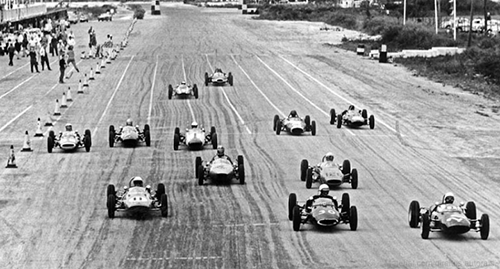
Start of one of the heats. (credits Bahamas News Agency, Terry O'Neil)
So it was Friday the 7th. For the first time that year for FJ cars, it was time to race hard at Oakes Field. 11 cars would take part in the first heat, with a good balance ratio between all the vehicles and drivers present. Even so, the sprint race was marked by the dispute between two drivers, Rob Nethercutt and Pete Lovely, who fought intensely over the five laps.
In the end, Lovely did better by not only managing to secure the victory in the heat but also setting a new lap record for Formula Junior cars on the circuit. However, Nethercutt was not far behind, remaining very close to Lovely until the final flag. Rounding out the heat's top-three was Floyd Aaskov, in a Lotus 20.
The second heat was marked by another personal show by Lovely, with the American leading from start to finish. The real attraction was due to the dispute for second, third and fourth places between Ernie de Vos, Nethercutt and A. Gottlieb. De Vos and his brand-new Brabham BT2 were the ones that stood out from this small group, thus securing a great second place (even if already reasonably distant from Lovely).
And the driver who managed to secure the last place on the podium was Gottlieb who, taking advantage of a reduction in Nethercutt's pace, managed to grab third place, guaranteeing the last spot on the front row for the Pan-American Race, which was scheduled to take place on the 12th.
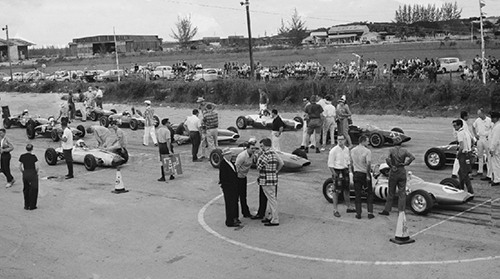
Getting ready for the Pan-American race. (credits Karl Ludvigsen Photograph Collection & the Revs Institute)
Five days passed until the final race presented itself to the drivers. In this interlude, which promised to be a time for the final adjustment of the machines, the track claimed new victims for the FJ grid: Roger Penske, who had not participated in the first two sprint races, had a very serious accident with his Lotus in one of the free sessions, just the day before the Pan-American Race.
After losing control of the car at the entry to one of the circuit's high-speed corners, the Lotus overturned several times, coming to rest on a guardrail. Penske was unharmed in the accident, but the driver was forbidden to take part in the race due to medical precautions.
Besides Penske, Mayer failed to solve his problems with his Cooper and would also be absent from the race. In this way, there would be 14 drivers assuming their starting spositions for in the 12-lap race.
After the start was given, Rob Nethercutt shot in the lead, followed by Gottlieb and Lovely. As usual in this race, the winners of the sprint heats were not very lucky at the Pan American, and it was not long before Lovely began to lose pace in front of his opponents.
Within a few laps, the driver had already been overtaken by De Vos, who was now fixing Gottlieb's second place in his crosshairs. Further back, some drivers started to face some problems, with W. Kirtley and H. Elliot being the first ones to retire.
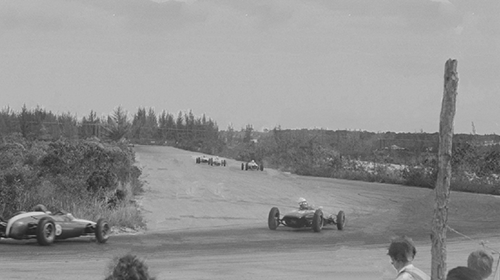
Time for the chase. (credits Karl Ludvigsen Photograph Collection & the Revs Institute)
In comparison, everything looked great for Nethercutt who saw his advantage over his competitors increase with each passing lap. At the same time, De Vos and Gottlieb were in a skirmish for second, until Gottlieb's Lotus 22 started to fall back, which made De Vos' life substantially easier.
But the happiness of second place did not last long for De Vos, as his Brabham BT2 was also starting to feel the effects of the exhausting Oakes Field circuit. Within a few laps, he was just another one in the pits. It was at this point that Hugh Dibley and Peter Revson took second and third positions as both overtook the struggling Lovely.
In its final laps, the race was more about trying to get to the finish line than really fighting for a better position. Nethercutt was already well ahead of the rest of the field, with Dibley and Revson also securely in place. And so it went on, until the remaining six cars crossed the finish line at Oakes Field for the last time.
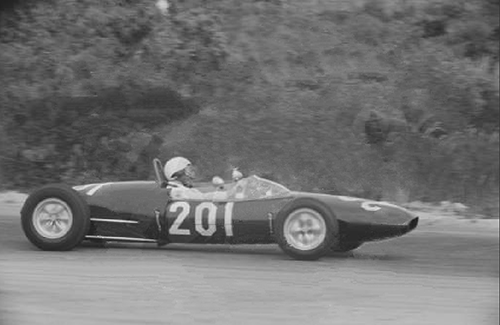
Nethercutt ran out to a dominant win in his #201 Lotus-Ford 22.
(credits Karl Ludvigsen Photograph Collection & the Revs Institute)
Rob Nethercutt had destroyed the competition, due to the combination of his overwhelming presentation on the circuit, the great performance of his Lotus-Ford 22, plus the fact that his main opponents were systematically decimated due to mechanical failures over the 12 laps of the Pan-American Race.
And this is it. This race would mark the final chapter of Formula Junior in the Caribbean islands. Even if many of the FJ cars were still in the region during the following years, in countries like El Salvador, Guatemala and Honduras, only in Mexico and the south of the United States (especially in Florida) would organise races of the category at least until its official dismissal in late 1963.
Even so, Formula Junior will always be remembered for being one of the pioneers in standardizing a single-seater category on a world stage, and for allowing so many to, at least momentarily, know what it was like to be one step away from the eternal glory of F1.
Why read me?
The history of Formula Junior racing in the Caribbean is an obscure topic, only covered in a few rare books which are generally out of reach of the general public. In addition, many of the documents that existed about these races were lost over the time, with most of what was left represented only by a handful of photos and a few files scattered between pages of newspapers and automobile associations.
Another problem with Formula Junior in the region is that many times it was forced to compete with cars from other categories simultaneously, due to the simple factor of lack of entries, meaning that it was obliged to run in Formula Libre races/regulations. For example, there is a reasonably well-documented race in 1960 in Santa Ana, El Salvador, where Duncan Forlong competed for the main trophy in his Gemini Mk2 FJ, while his opponents drove Porsche Spyders, Austins 100 and Mercedes 300Sl!
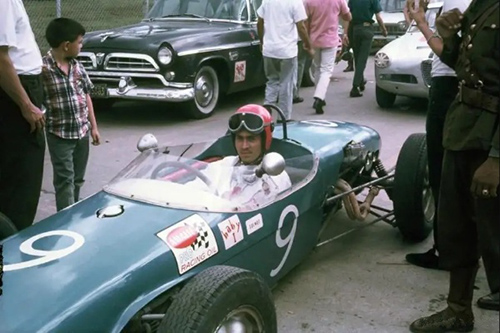
Another survivor from the Formula Junior days, this Lotus 18 arrived in Venezuela in the early sixties, to be raced by Max Ciarlet. The car participated in at least three races in its original FJ configuration, before being adapted around 1967-'68 to compete in Formula Vee. (credits Alfredo Bruk)
Therefore, it is very difficult to differentiate what was a race clearly aimed at Formula Junior or open to Formula Libre, even more so with the lack of documents that can prove one version or another. For this reason, only six races in the Caribbean zone between 1960 and '62 were listed; because for those I did find documentation and reports demonstrating their intimate interaction with Formula Junior.
However, a valid question that can be asked is why races in South Florida and Mexico were not included as well, as both are also part of the Caribbean zone? For the first, the choice seemed logical to me: to comment on the FJ races in Florida, the text itself would be too long, as it would be impossible to talk only about the races in the state without talking about the wider scope of the SCCA and the Southeast Division.
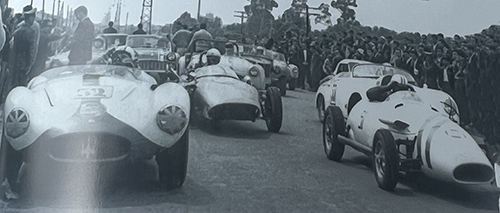
This photo is a nice portrait of the fate of Formula Juniors in the Caribbean after the disbandment of the category. Taken in Colombia, probably in 1964, this photo shows the Formula Junior Stanguellini driven by Armando D'Ambrogio (right), a Formula Caribe (middle) driven by Guillermo Piescachón and a Grand Touring Maserati (left), owned by Leopoldo Barbosa, as well as numerous other cars, competing in the same race! (credits Jose Clopatofsky)
In the case of Mexico, it would also be impossible to list all the official races in the category in this succinct text. From what I could find in my research, there were at least 10 official FJ races in the country between the period from 1961 to 1963 – which adding to what has already been written would make the text extremely boring and tiring for any reader.
In this way, I hope that at least my initial intention to give a small sample of what was epic about Formula Junior in the region has been fulfilled. So maybe if you close your eyes you'll be transported to Nassau in 1961: beautiful white sand beaches, a tropical sun and, suddenly, a sharp noise – one that gradually builds, until it becomes a high-pitched scream: the sound of Formula Junior.
Main acknowledgements
- The Fastlane, FJ sub-section
- The Bahamas Speedweeks, by Terry O´Neil
- Motor Racing at Nassau in the 1950s & 1960s, by Terry O´Neil
- American Racing: Road Racing in the 50s and 60s, by Tom Burnside and Denise McCluggage
- Cuban Newspapers Diário de la Marina and Prensa Libre: 1960, editions from 17th February till 1st March
Special thanks to
- The Revs Institute (and its contributors) for most of the photos
- The SCCA, through the IMRRC (International Motor Racing Research Center) for making available some archives
- Autosport's Nostalgia Forum guys who provided me with great sources of research
